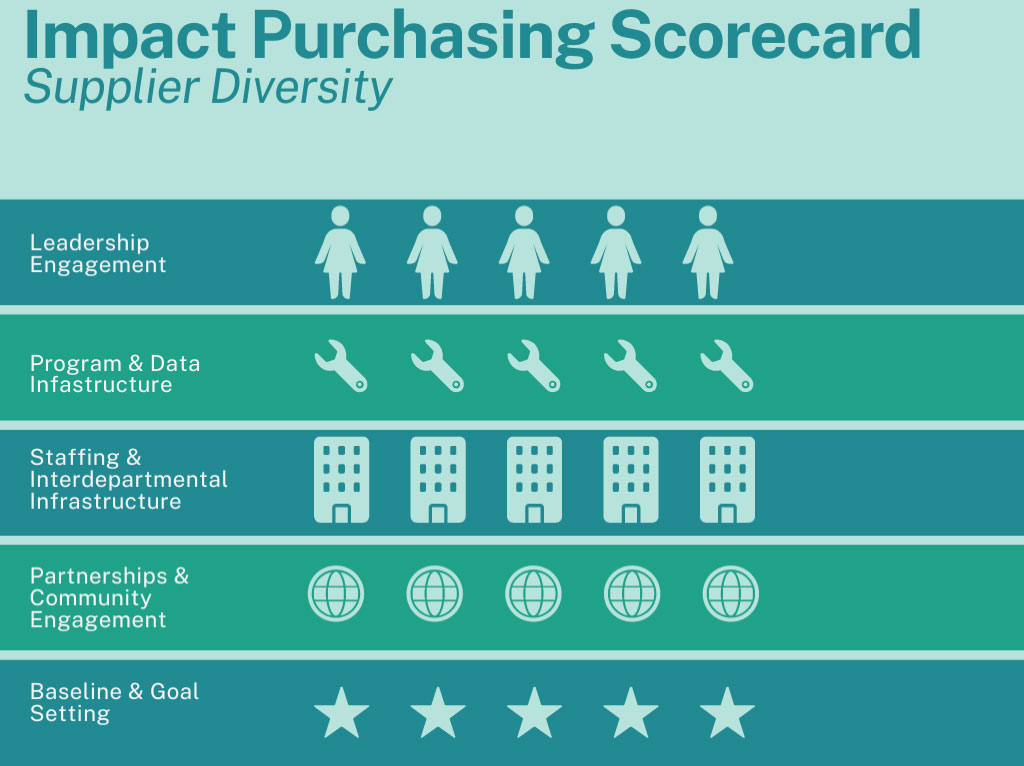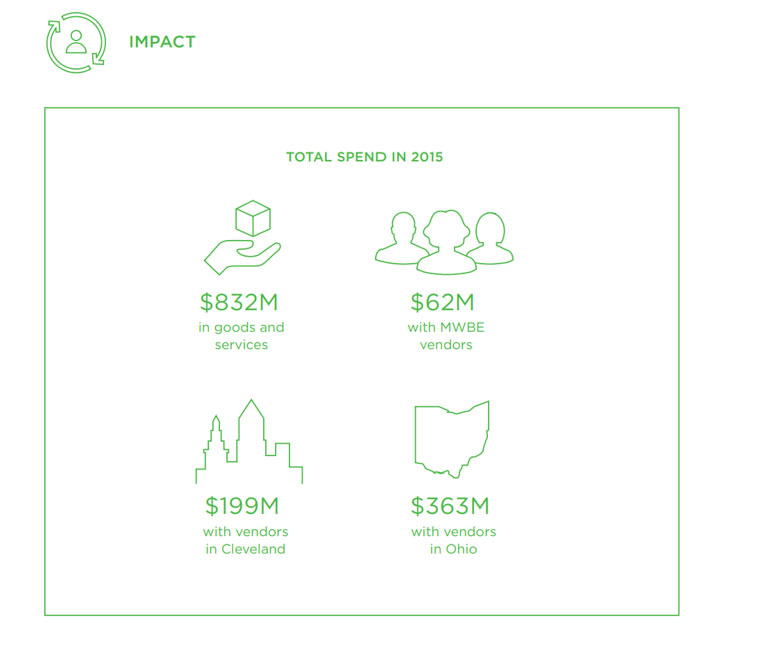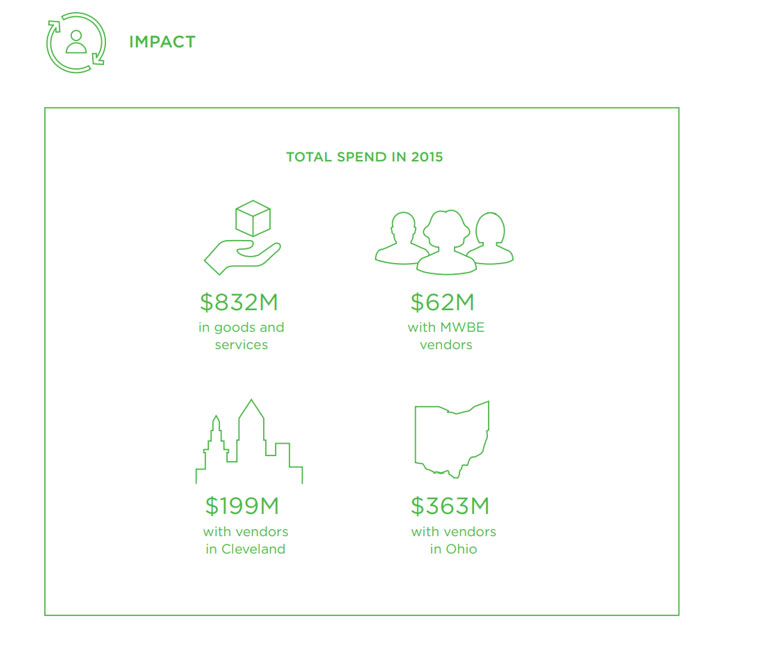
SMI Supplier Diversity Playbook - Appendix
Appendix
Definitions and exerts within the Supplier Diversity Playbook and outlined below are provided from:
Chapter 1. Setting the Stage, Building a Successful Supplier Diversity Program
Sources Referenced
- NHE Fact Sheet CMS
- AHA 2023 Cost of Caring
- Can Hospitals Heal America’s Communities? “All in for Mission” is the Emerging Model for Impact (Takoma Park, MD: The Democracy Collaborative, 2015)
- ASPE HHS
- Boston Medical Center Sustainability Bond( ESG)
- World Health Organization Healthy Equity
- CDC Racism and Health
- CDC Core Commitment to Health Equity
- Community Health Needs Assesement, IRS
- Gartner Top 25 Global Supply Chain
- US News Health Equity Measures
- Gartner Six Strategies to a Resilient Supply Chain: Gartner’s Healthcare Supply Chain Top 25
- Michigan Minority Supplier Development Council 333 Years to Parity
- 5 Steps in Change Management, Harvard Business Review Change Management
Definitions
Environmental Social Governance (ESG) Environmental, social, and governance (ESG) refers to the three central factors in measuring the sustainability and societal impact of an investment in a company or business.
Environmental
Governance
Definitions below are from The Healthcare Anchor Network member “Fiscal Year 2023 Data Companion” guide unless otherwise indicated.
Supplier Diversity refers to an organization’s supplier base and the degree to which those businesses are owned by diverse suppliers. The industry standard for a supplier to be recognized as diverse is that it be at least 51% owned, managed, and operated by minorities, women, veterans, or other designated groups that have historically been underrepresented in industry supply chains.
Supplier Diversity Certifications Defined
Social Determinants of Health: The World Health Organization defines the social determinants of health as “the conditions in which people are born, grow, work, live, and age.” They represent the wider set of forces and systems shaping the conditions of daily life that drive health outcomes, such as inequality, social mobility, community stability, and the quality of civic life. Sometimes referred to as “upstream” determinants, research indicates that up to 50 percent of the factors that contribute to health are social and economic.
Health equity refers to the notion that all people should be able to achieve their highest level of health, regardless of their race, gender, class, sexual orientation, or other identities. Achieving health equity requires addressing the systemic factors shaping the social determinants of health.
Industry Partner: SMI to provide
Healthcare Provider: SMI to provide
Supplier diversity refers to an institution’s vendor base, and the degree to which the businesses institutions procure from are owned by diverse suppliers. It has developed as an industry term to refer to working with businesses that are at least 51% owned, managed, and operated by businesses owned by minorities, women, veterans, or other designated groups that have historically been underrepresented in industry supply chains. Many institutions require third-party certification for participation in their supplier diversity programs.
Health The World Health Organization’s definition of health: is “a state of complete physical, mental, and social well-being, and not merely the absence of disease or infirmity.” Health equity refers to the notion that all people should be able to achieve their highest level of health, regardless of their race, gender, class, sexual orientation, or other identities. Achieving health equity requires addressing the systemic factors shaping the social determinants of health.13
Community Health Needs Assessment (CHNA) is a research process non-profit hospitals must implement as part of their community-benefit reporting. Instituted by the Affordable Care Act of 2010, CHNAs must be completed by hospitals and health systems every three years and identify the most pressing community health concerns.
Anchor Institutions are nonprofit or public institutions that are firmly rooted in their locales, including hospitals, universities, local governments, and utilities. These institutions often have a social or charitable purpose, and unlike for-profit corporations that can relocate, are place-based and tend to stay put. As such, they have a vested self-interest in helping to ensure that the communities in which they are based are safe, vibrant, healthy, and stable.1 Anchor Mission A commitment to consciously apply the long-term, place-based economic power of the institution, in combination with its human and intellectual resources, to better the long-term welfare of the community in which the institution is anchored.2
Executive Leaders are the senior leaders of the organization responsible and accountable for budgeting, people management, and operating practices.
Group Purchasing Organization (GPO) A Group Purchasing Organization (GPO) is an entity that aggregates purchasing volume with the objective of achieving cost savings for its members by negotiating deals with vendors, distributors, and manufacturers.† Participating institutions engage in a contract with a GPO by becoming members, and agreeing to direct a certain percentage of their spending through the organization rather than engaging in contracts directly. According to the Healthcare Supply Chain Association, more than 70% of purchases that U.S. hospitals make are done through GPO contracts. A GPO is one type of Supply Chain Integrator.
Tier Two Spend is the dollar amount of operating expenses and capital non-construction related expenses that was spent during the fiscal year with vendors that are suppliers to your health system’s direct vendors (may or may not be subcontractors).
Inclusion Resource Groups (IRG) or Employee Resource Groups are voluntary committees typically led by Diversity, Equity and Inclusion focused on a shared background or interest and aim to foster inclusion, cultivate diversity and create resources and support for diverse employees.
Chapter 2. Getting Started with Supplier Diversity Self-Assessment and Goal Setting
Supplier Diversity Maturity Model (picture- see excel file for full maturity model)
Supply Chain Integrators or Entrepreneurial Support Organization For the purposes of this toolkit, the terms Supply Chain Integrators or Entrepreneurial Support Organization refers to organizations that strengthen the capacity of small, local, diverse, and/or employee-owned businesses to serve institutional purchasers. In this context, these organizations include technical assistance providers, business incubators, organizations that help connect businesses to capital, and supplier development councils.
Addressable Spend (as defined by the Healthcare Anchor Network): Total Spend minus the expense categories listed below. Construction expenses should be separated out and not be included in this count, as outlined in the category list below:
Total Spend (as defined by HAN) is the summed dollar amount of all operating, capital and construction expenses incurred during the fiscal year with direct suppliers to your health system, minus the expense categories listed below:
Impact Purchasing Scorecard- Supplier Diversity

Example of how you could track your data at an organizational level including
Tier 1 and Tier 2 diverse supplier spend.

Below is an example of the marketing success of your program:

Chapter 3. Measure What Matters, Supplier Diversity Definitions and Metrics
Definitions
Addressable Spend (as defined by the Healthcare Anchor Network): Total Spend minus the expense categories listed below. Construction expenses should be separated out and not be included in this count, as outlined in the category list below:
Optional Exclusions :
Supplier Diversity Definitions to know:
Example 1. Below f how you could track your data at an organizational level including Tier 1 and Tier 2 diverse supplier spend5.

Example 2. Below is an example of the marketing success of your program5:

Example 3. Supplier Diversity Dashboard Example from Federal Government Small Business Contracting Goals.

Example- Federal Government Dashboard: https://d2d.gsa.gov/report/supplier-base-dashboard
Chapter Four. Internal Engagement for Growing Supplier Diversity
Sources Referenced
Pew Research “Diversity, Equity and Inclusion in the Workplace” 2023.
Kaiser Permanente’s “Impact Spending website” https://supplier.kp.org/impactspending/what-we-do/supplier-diversity/
Target 2022 Sustainability Report https://corporate.target.com/sustainability-governance/governance-and-reporting/reporting-progress/archive
Chapter 5 Developing Strategic Partnerships
Table 1. Current Partner Engagement Mapping, identify existing external partners your organization is partnered with.

Table 2. Identify your external partners, cultivate a list of potential external partners and who the internal contact is within your organization.

Chapter 6. Diverse Supplier Development and Capacity Building
Table 3. Template of criteria needed to identify potential opportunities for inclusion of diverse suppliers in upcoming contracts.

Chapter 7. Available Technology Solutions
Table 1. Table of questions to ask technology suppliers
| Name of Technology Platform | Technology Platform is Diverse Ownership (Y/N) | Technology Platform is a Third-Party Certified Diverse Suppliers (Y/N) | Technology Platform Ability to Perform Data Scrub (Y/N) | Number of Diverse Supplier certifications Included | Technology Platform includes a Supplier Diversity Dashboard (Y/N) | Frequency of Platform Updates | Includes a Diverse Supplier Directory (Y/N) | Technology Platform Ability to Integrate into ERP (Y/N) |
| Example 1 | Y | Y | N | N/A | Y | Quarterly | Y | Y |
| Example 2 | N | N | Y | 100 | N | Ad Hoc | Y | Y |
| Example3 | Y | N | N | N/A | Y | Quarterly | N | N |
Table 4. Sample of questions to ask technology suppliers
| Name of Technology Platform | Technology Platform is Diverse Ownership (Y/N) | Technology Platform is a Third-Party Certified Diverse Suppliers (Y/N) | Technology Platform Ability to Perform Data Scrub (Y/N) | Number of Diverse Supplier Certifications Included | Technology Platform includes a Supplier Diversity Dashboard (Y/N) | Frequency of Platform Updates | Includes a Diverse Supplier Directory (Y/N) | Technology Platform Ability to Integrate into ERP (Y/N) |
| Example 1 | Y | Y | Y | N/A | Y | Quarterly | Y | Y |
| Example 2 | N | N | Y | 100 | N | Ad Hoc | Y | Y |
| Example 3 | Y | N | N | N/A | Y | Quarterly | N | N |
Examples of successful web platforms from the HAN Inclusive, Local Sourcing Toolkit Pages 111-115
1. MD Anderson Cancer Center, based in Houston, Texas MD Anderson maintains a website that vendors can access even before registering with the institution. All bids over $50,000 are listed publicly, ensuring that all local vendors may access bids and review requirements. The website also includes historical information, which local small business development centers can use to create mock bids with businesses to help them learn about the Request for Proposal process. The website also includes details on how to make an appointment with MD Anderson staff members. It features important resources for Historically Underutilized Businesses (HUBs), including information on how to become a HUB, templates for the required HUB subcontracting plan, along with an instructional video, and state goals for HUB spending.

Above: webpage for MD Anderson’s HUB & Federal Small Business Program

Above: webpage listing open bid opportunities at MD Anderson
Chapter 8. Strategic Sourcing RFP Requirements for Suppliers
Visual Example 1. Impact Purchasing Integration into the Sourcing Process

Visual Example 2. Supplier Diversity Technology Integration into the Sourcing Process

Visual Example 3. Equity in Sourcing, end-to-end process

Table 5. Evaluate your Bid Process
Review bids submitted to determine if diverse vendors are included in the process. With this information, you can further explore if your lack of diverse suppliers is due to participation or other factors. Understanding their current participation can help identify whether your efforts, to begin with, should be focused on outreach or capacity building.
Table 6. Evaluate upcoming contracting opportunities
The first step to integrating diverse suppliers into your sourcing process is identifying potential opportunities for engagement. A great place to start is inquiring with your purchasing department what their contract renewal process is. Determine if you’re able to pull contract data by expiration date. Leverage the list of goods and services below as a starting place to determine upcoming bid opportunities for diverse suppliers.
Table 4. Image from Hospital-Toolkits-Inclusive-Local-Sourcing.pdf page 80
Table 7. Supplier RFP Response Scoring Criteria
The supplier RFP responses scoring criteria provide a measurable process to evaluate performance in key areas.
Table 8. Supplier Diversity Weighted Scoring Criteria and Scoring Examples
The scoring above outlines the importance of these components to the overall supplier diversity program. These components can be populated by utilizing the RFP questionnaire for suppliers and the Likert scale to compare efforts between companies. According to the example above, Supplier A has a stronger program.
Many successful procurement departments create weighted scorecards to standardize the evaluation of suppliers and inform decisions. Best practice would include supplier diversity as one of the measurable faucets to awarding a bid. For example, supplier diversity as a factor in weighting supplier responses could look like:
Based upon the criteria above, Supplier A had a better overall supplier diversity score and total score. It’s likely that they would be awarded the bid.
Questionnaire 1. Internal evaluation of your procurement policies and practices
Key categories to evaluate to within your procurement practices to integrate supplier diversity include:
Once you’ve identified your current approach, you can explore opportunities to continue to integrate supplier diversity language.
Questionnaire 2. Future contracting opportunities
List potential future procurement opportunities below for diverse vendors. These could include new facilities, retrofits, increasing sustainability through retrofits, etc.
Questionnaire 3. Feedback Questions to Engage Diverse Suppliers in Process Improvement
Identify vendors from underserved communities that are already present in your area. Either by yourself or working through a community partner, conduct focus groups or interviews with these diverse vendors to assess how they perceive working with your institution:
Questionnaire 4. RFP Questionnaire for Suppliers
A sample list of questions organized by categories to provide to suppliers for an RFP or RFI. These questions provide a clear understanding of their current supplier diversity programming. This is a different way of sending out information to the supplier. Once a response is received, place the information into Table 1. Supplier RFP Response Scoring Criteria to compare multiple supplier responses.
